Washday
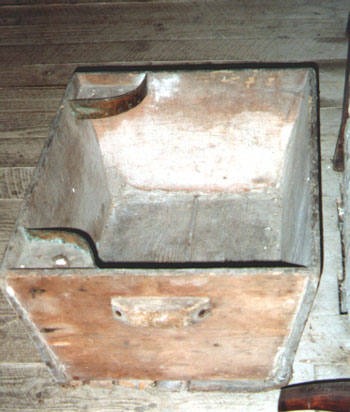

Mondays
Monday was the traditional washing day, but in winter the drying from washday could go on all week!
Washing involved an early start to get the water hot, and lots of hard work, carrying water to the tub or - if you were lucky - the washing machine.
If you used any of these washtubs or machines, we'd like to hear from you. Email us [sue at fellponymuseum.org.uk] or add your comments to the guestbook.
There was no electricity in many areas of the Lake District until the 1950s and 1960s. Washing day meant lots of hard work. Cold water was piped to the house, but often it had to be ladled by hand into a copper and then heated for the day's wash.
Clothes had to be stirred about in the water to remove the dirt, and some items, such as white collars on Sunday shirts, needed scrubbing.
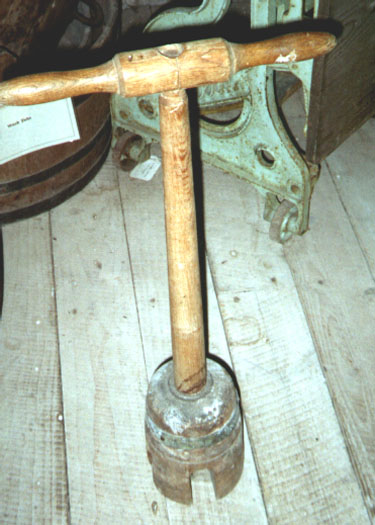
Some of the Museum's washing machines have handles, wheels and gears to stir the clothes, but the most basic is just a box with a soap shelf. This was often used to scrub the collars and cuffs of shirts on a washboard to get serious dirt out before the real wash. Then they went into the "poss tub" or "dolly tub" where clothes were dunked and swirled vigorously with the "posser" or "dolly". Whites, especially white cottons, were boiled, and got a tiny dose of "dolly blue" dye to enhance their brilliance.
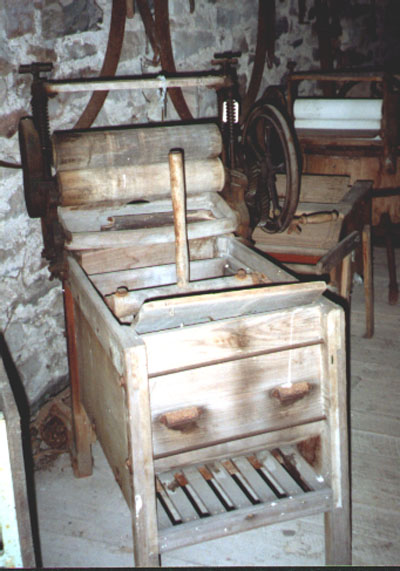
The washed clothes had to be "mangled" to get the water out. This was a hot, steamy job calling for strength to lift the wet, heavy material out of the tub using sprung wooden tongs; and skill to feed enough of the cloth into the rollers for the mangle to get a grip. Then more effort to turn the handle and squeeze the clothes through the rollers. There was a skill in getting just the right pressure on the mangle for the type and volume of material. It also helped if you did some preliminary folding, because it did save a bit of ironing later. With luck, the weather would be warm and breezy, and clever pegging out on the washing line would use the wind to get rid of more creases as well as drying the clothes. Finally, the washtub or machine had to be emptied by hand.
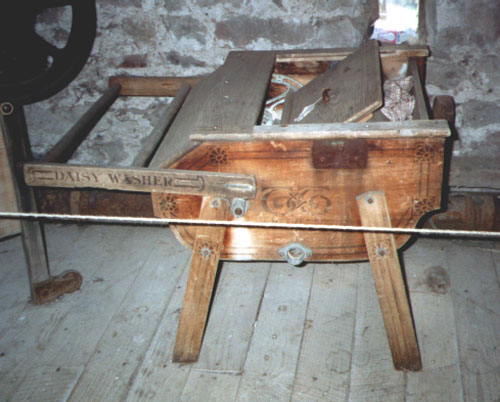
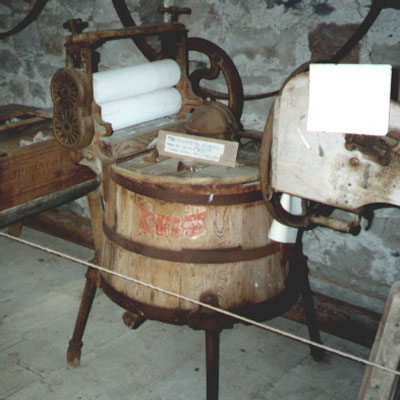
If the weather was too bad to get the clothes out onto the washing line, they hung round the house on clothes horses or on "pulleys" hung from the ceiling over the kitchen stove, getting in everyone's way. Once clothes were almost dry the creases had to be removed, so they were pressed with a series of flat-irons heated on the stove or by the fire; and finally "aired" before being put away until wanted.
WASHDAY IN THE 1940s
Maggie B Dickinson
I was brought up in the East Lancashire village of Barrowford where virtually everyone was involved in some aspect of the textile industry. My father was a foreman bleacher at a factory nearby and my mother, who had been a weaver in Blackburn, was a housewife.
Many women, like my mother, were expected to absorb themselves in the role of housewife if their husbands were well paid or employed as policemen. Policemen’s wives and women who had been schoolteachers had to cease work once they married. There was probably a long list of other stipulations why females faced similar barriers.
In Lancashire many children were “latch-key Kids” who let themselves in after school by extracting the door’s key, that hung from a string nailed to the inside of the door, by fishing it out through the letter box. It [mothers working as well as fathers] is the reason why more families in the North West than elsewhere were able to buy their homes rather than rent them.
The weavers must have arisen exceptionally early to get their washing done and “pegged out” before going to work. The “knocker uppers” provided a valued service – men and women who were paid to rattle bedroom windows at the allotted time with a wooden pole [and in at least one case, a peashooter!] This is because in many places mill gates were locked at a specific time and those who were late were turned away for the day. Fortunately my father had an alarm clock.
Around 6am every day there was a drumming of clogs as the weavers, winders and tacklers who worked at Higherford Mill nearby would be off to an early start. At 7.30 the clogs thundered back as they went home for breakfast, drumming to the factory again not much after 8am clutching their lunch-time sandwiches. Their day lasted almost 12 hours. At Higherford Mill many of them wove jacquard for which they were very highly paid. An industrial hazard was that a high percentage of weavers suffered from tinnitus through the thundering noise of looms and went deaf in later life.
High-spec cottons (Egyptian and Sea Island staples) were commonly used for making sheets, pillowcases and underwear. What lasts vividly in my memory is the strong competition from each household to have the whitest whites, aided by Dolly Blue that probably came from Backbarrow, Lancashire North of the Sands.
The full wash took place only on Mondays, when lines were strung across the front and back streets by every household. Refuse collections weren’t on specific days but traditionally they didn’t collect on wash day.
I’m going back to Monday mornings during school holidays and I’ve been wakened first by the workers and then the lovely soothing sound of washing flapping in the wind, and a warm breeze wafting over me from the open bedroom window.
The lengthy rigmarole of laundry started on Sunday night with the soaking of whites in a dolly tub which was attacked with a “posser” to loosen the dirt overnight, and this included non-working shirts. Come Monday morning the copper gas boiler was lit and the water heated to almost boiling point. Into this went the whites which were agitated by using a handle attached to paddles.
The same water was used for coloureds and then work clothes like boiler suits, followed by woollens once the water had cooled. While the water was heating the shirts and similar items were either rubbed up and down on a washboard or had their collars and cuffs scrubbed on the draining board of the sink.
Once the process was finished the water from the boiler was used to swill the yard and the flags and doorsteps were scrubbed. Then either a yellow or white stone was applied to the steps. These stones were your payment from the rag-a-bone men who came round with a horse and cart, taking your unwanted goods such as clothing. What on earth the ‘bone’ was about I have no idea.
The boiler was re-filled with cold water and everything was rinsed before passing through a mangle but not before the whites had been put separately into a dolly tub of cold water to which Dolly Blue was added.
Our mangle was really huge with cast iron sides, so that we could fold items several times before turning the heavy handle. Underneath the back of the mangle a large bucket caught the water that was extracted.
The following day was absorbed with the ironing. Some of our neighbours had the old flat irons that were warmed on a ledge in front of the fire of an old cast iron range. My granny in Blackburn had one of these and I would help her polish it with black lead until it shone. Bread was excellent from the side oven of these. Pans were hung over the flames, and wood was kept in the other side oven. Fortunately mum had an electric iron.
When the ironing was finished the pristine bedding and clothing was hung from a wooden rack that was suspended from the ceiling, being operated by a rope and pulley. The rack came in handy for drying hand washing done during the rest of the week and washdays during the winter months. Also there was the facility of washing lines in back yards.
Consequently, through lack of time, the evening meal was usually made from the left-over Sunday joint with added potatoes and vegetables, and known as beef hash.
2 September 2020